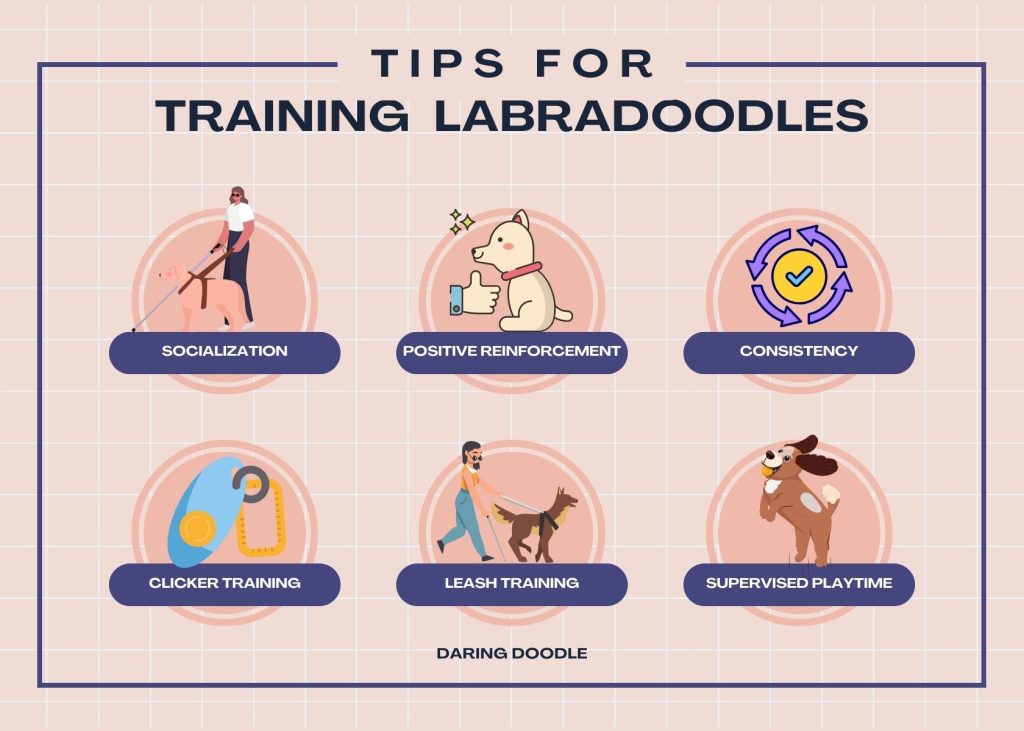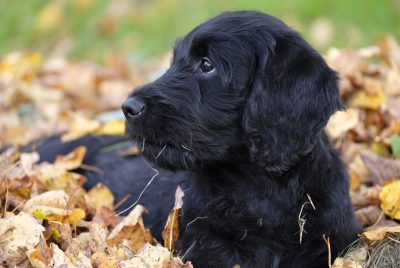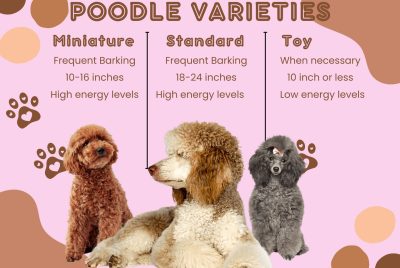Labradoodle Retriever 101: Everything You Need to Know
Selecting the ideal family pet can often feel like navigating a complex maze, with an overwhelming array of options and breeds at your disposal. Among these, Labradoodle Retriever — a delightful mix between Labrador Retrievers and Poodles—have risen to prominence as a firm favorite among families.
Their intelligence, warmth, and hypoallergenic coats combine into an attractive package for any dog enthusiast.
Having dedicated over ten years to working closely with various dog breeds, with a particular fondness for designer ones like Labradoodles, I’ve gained not only foundational knowledge but also deep insights into what makes each Labradoodle stand out in their own special way.
Stick around as we explore how adding a Labradoodle to your family could be the game-changer you’ve been searching for.
Key Takeaways
- Labradoodles came to life in the late 1980s in Australia, created to be hypoallergenic guide dogs by mixing Labrador Retrievers and Poodles.
- They have diverse coat types and colors, including black. Their coats are a big plus for people with allergies, thanks to the low-shedding quality inherited from their Poodle lineage.
- These dogs are famous for their friendly and intelligent personality. Training them is usually easy because they are eager to please and quick learners.
- Labradoodles can have various health issues like hip dysplasia and bloat but living a healthy life is possible with proper care, regular vet check-ups, and grooming.
- There are different types of Labradoodles based on their generation of breeding, such as F1 and F1B Labradoodles, which affects their coat type and other traits.
Understanding Labradoodle Retriever Breeding: Origins and Follow-on Programs
Labradoodle breeding has a fascinating history that stems from the intentional crossbreeding of Labrador Retrievers and Poodles. This deliberate mix was aimed at creating intelligent, friendly, and easy-to-train dogs with different coat types to serve as guide dogs for allergy sufferers in follow-on programs.
Breeding history and origins
The Labradoodle first came into existence in the late 1980s in Australia. A breeder named Wally Conron aimed to create a hypoallergenic guide dog for a visually impaired woman whose husband was allergic to dogs.
By crossbreeding a Standard Poodle with a Labrador Retriever, Conron hoped to combine the gentle, trainable nature of the Labrador with the low-shedding coat of the Poodle. The effort was successful, giving rise to what we now know as the Labradoodle.
This hybrid quickly gained popularity not just for its hypoallergenic qualities but also for its friendly and intelligent personality. People discovered that Labradoodles make excellent family pets due to their happy demeanor and ease of training.
As demand grew, so did diversity within the breed, leading to various types including standard and miniature sizes, along with different coat textures and colors such as black Labradoodles.
This rich breeding history underscores how Labradoodles have become cherished companions worldwide.
Follow-on guide-dog breeding programs
After learning about the breeding history and origins of Labradoodles, it’s intriguing to delve into the follow-on guide-dog breeding programs. These specialized programs focus on further refining the desirable traits and characteristics of Labradoodles for their roles as guide dogs.
This involves carefully selecting parent dogs with specific temperaments, intelligence, and hypoallergenic qualities to produce offspring that are not only friendly and intelligent but also well-suited for service work.
Labradoodles have gained attention for being highly trainable and having a gentle disposition, making them ideal candidates for guide dog training programs. These initiatives aim to create a consistent line of Labradoodles specifically bred to serve as guide dogs for individuals with visual impairments or other disabilities.
Types of Labradoodle Retriever
Labradoodles come in various types, depending on the generation of their breeding. They can be categorized as follows:
- F1 Labradoodles: These are first-generation Labradoodles, with one purebred Poodle parent and one purebred Labrador Retriever parent. They exhibit a diverse combination of traits from both breeds.
- F1B Labradoodles: This type results from crossing an F1 Labradoodle with a Poodle. It often features a curlier, hypoallergenic coat due to the increased influence of Poodle genetics.
- Multigenerational Labradoodles: These are bred from two Labradoodles, or from a Labradoodle with multigenerational heritage. They offer more consistency in terms of temperament and coat characteristics.
- Australian Labradoodles: Originally bred to be service dogs, they are a mix of Labrador Retriever, Poodle, and Cocker Spaniel. They typically have a curly or wavy fleece coat and are known for their trainability and friendly nature.
Understanding the different types of Labradoodles can help prospective owners make informed decisions based on their specific preferences and lifestyle needs.
Labradoodle Retriever Health and Grooming Needs
Labradoodles require regular grooming to maintain their coat’s health and prevent matting, while also needing frequent brushing to minimize shedding. Health-wise, Labradoodles are generally healthy dogs; however, they may be prone to certain genetic health issues like hip dysplasia and bloat that need close monitoring and early intervention.
Common health issues and how to care for them
Labradoodles may experience some common health issues, but with proper care, they can lead healthy lives. It is important to be aware of these potential health concerns and take proactive steps to address them. Here are some common health issues that Labradoodles may face and how to care for them:
- Hip Dysplasia: A common issue in larger dog breeds, including Labradoodles. Regular exercise and maintaining a healthy weight can help reduce the risk of hip dysplasia.
- Ear Infections: Due to their floppy ears, Labradoodles may be prone to ear infections. Regularly inspecting and cleaning their ears can help prevent this issue.
- Progressive Retinal Atrophy (PRA): This genetic condition can lead to vision loss in Labradoodles. Regular eye check-ups can help monitor any signs of PRA.
- Allergies: Labradoodles may be prone to skin allergies. Providing a balanced diet and keeping their coat clean through regular grooming can help manage allergies.
- Gastric Dilatation-Volvulus (GDV): Also known as bloat, this condition is more common in deep-chested dogs like Labradoodles. Feeding smaller meals and avoiding vigorous exercise after eating can help prevent GDV.
Caring for a Labradoodle’s health involves being attentive to their specific needs and taking preventive measures when necessary, promoting a long and happy life for your furry companion.
Recommended screenings for general health
Labradoodle Retriever benefit from regular health screenings to maintain their well-being, as they are susceptible to certain health issues. It’s essential to schedule routine check-ups with a veterinarian for assessments like hip and elbow evaluations, eye exams, and heart tests.
These screenings can help detect potential concerns early on and ensure appropriate interventions are in place. Additionally, considering the breed’s susceptibility to skin conditions due to their curly coat, it’s advisable to include dermatological assessments during vet visits.
Furthermore, Labradoodle owners should prioritize preventive care such as vaccinations and parasite control. Regular blood tests can also aid in monitoring overall health status and identifying any underlying abnormalities that may require attention.
Grooming needs and coat care
Labradoodle Retrievers have specific grooming needs that are essential for maintaining their coat’s health and appearance. It’s important to regularly brush their coat to prevent matting and remove loose fur, especially if they have a wool or fleece coat. Additionally, Labradoodles should be bathed every 6-8 weeks using a gentle dog shampoo to keep their skin and fur clean.
Trimming their coat every 6-12 weeks is crucial to prevent overgrowth and maintain a neat appearance. When it comes to ear care, cleaning the ears regularly can help prevent infections and maintain overall ear health. Nails should also be trimmed every few weeks to prevent overgrowth and discomfort for your Labradoodle.
It is advisable to consult a professional groomer for specific advice on grooming tools, techniques, and products tailored towards your Labradoodle’s unique coat type. Regular grooming not only keeps your Labradoodle looking its best but also contributes to its overall well-being by preventing skin issues and promoting healthy coat growth.
Moving onto the next section about “Training and Behavior Tips for Labradoodles,” let’s delve into effective methods for understanding and training these intelligent designer dogs.
Training and Behavior Tips for Labradoodles

When training Labradoodle Retrievers, use positive reinforcement and be consistent in your approach. Understanding their energetic and intelligent nature can lead to a strong bond with these designer dogs.
Labradoodles have a friendly and intelligent personality, making them perfect companions for families or individuals. They are known for being easy to train, owing to their intelligence and eagerness to please.
Labradoodles often exhibit a playful nature, which makes them great with children and other pets. Their mix of genetics from the Labrador Retriever and Poodle results in an affectionate and loyal disposition.
Labradoodles also tend to be outgoing and social animals that enjoy interacting with people and other dogs alike. Their adaptable nature allows them to thrive in various environments, whether it’s a bustling family home or a quieter living space.
Effective training methods
Training a Labradoodle can be an exciting and rewarding experience. Using positive reinforcement methods can help form a strong bond and understanding between you and your furry friend. Here are some effective training methods to help guide you through the process of shaping your Labradoodle’s behavior:
- Socialization: Introducing your Labradoodle to various people, animals, and environments from a young age will help them become well-adjusted and friendly adults.
- Positive reinforcement: Rewarding good behavior with treats, praise, or toys will encourage your Labradoodle to repeat those actions in the future.
- Consistency: Establishing clear rules and consistently enforcing them will help your Labradoodle understand what is expected of them.
- Clicker training: Using a clicker as a marker for desired behavior paired with rewards can be an effective way to communicate with your Labradoodle during training sessions.
- Obedience classes: Enrolling your Labradoodle in obedience classes can provide structured training in a controlled environment, helping them learn essential commands and manners.
- Mental stimulation: Engaging your Labradoodle in interactive games, puzzles, or agility exercises can provide mental enrichment and prevent boredom.
- Leash training: Teaching your Labradoodle Retriever to walk calmly on a leash will ensure enjoyable walks for both of you while maintaining control in public settings.
- Patience and understanding: Being patient and understanding during the training process is crucial for building trust and confidence in your dog’s abilities.
- Avoid punishment: Instead of punishment, redirect undesired behaviors positively towards acceptable alternatives to encourage good habits.
- Supervised playtime: Allowing supervised play with other dogs can help develop social skills while providing physical exercise for your Labradoodle.
Fun activities for Labradoodles
Labradoodles are energetic and intelligent, making them perfect companions for a variety of fun activities. Here are some engaging activities to keep your Labradoodle entertained:
- Agility Training: Set up an agility course in your backyard or at a local dog park using tunnels, hurdles, and weave poles to keep your Labradoodle physically and mentally stimulated.
- Fetch: Labradoodles love to play fetch. Use a ball or a frisbee to engage in this classic game, which helps satisfy their natural retrieving instincts.
- Interactive Toys: Invest in interactive toys that challenge your Labradoodle’s problem-solving skills while providing entertainment and mental stimulation.
- Hiking: Take your Labradoodle on scenic hikes to allow them to explore new environments while getting plenty of exercise.
- Swimming: Many Labradoodles love water! Take them for a swim at the beach or in a pool to let them indulge in their natural water-loving tendencies.
- Obedience Training: Engage in obedience training sessions regularly to keep your Labradoodle mentally sharp and well-behaved.
- Dog Sports: Enroll your Labradoodle in activities such as flyball, dock diving, or even nose work classes to tap into their intelligence and athletic abilities.
- Playdates: Organize playdates with other dogs to provide social interaction for your Labradoodle, allowing them to burn off extra energy while having fun with their furry friends.
Engaging in these activities will not only help keep your Labradoodle physically fit but will also strengthen the bond between you and your beloved pet.
Size, cost, and lifespan of Labradoodles
I’ve always been fascinated by Labradoodles, partly because of their unique characteristics and partly due to my own experience owning one. These dogs are not just any pet; they’re a mix of two very popular breeds, bringing together the best of both worlds.
With their friendly demeanor and intelligence, they quickly become more than just pets; they’re family.
One of the first things I learned when I got my Labradoodle was understanding the specifics about their size, cost, and lifespan. This information was crucial for me to ensure I could provide the best care possible. Here’s a breakdown in a simple table format:
| Aspect | Details |
|---|---|
| Size | Standard Labradoodles can weigh between 50 to 65 pounds, while miniatures weigh around 15 to 25 pounds. |
| Cost | The initial cost can range from $1000 to $3000, influenced by the breeder’s reputation and the puppy’s lineage. |
| Lifespan | Labradoodles have a lifespan of approximately 12 to 14 years. |
This table encapsulates the primary considerations any potential Labradoodle owner should take into account. My experience taught me that understanding these aspects deeply impacts how well you can plan and care for your furry friend. Next, let’s explore the grooming needs and healthcare essentials to keep these adorable dogs in their best shape.
Allergies and hypoallergenic qualities
Labradoodles are often sought after for their hypoallergenic qualities, which make them a suitable choice for individuals with allergies. Due to their Poodle heritage, Labradoodles are known for their low-shedding coats, which can be more compatible with allergy sufferers compared to other breeds.
The mix of Labrador Retriever and Poodle in Labradoodles results in a coat that produces fewer allergens, making them appealing pets for those prone to allergies.
Additionally, it’s essential to note that while no dog breed is completely hypoallergenic, the minimal shedding and reduced dander of Labradoodles can help minimize allergic reactions in some people.
This makes them a favorable option for families or individuals seeking a companion without triggering severe allergic responses.
Labradoodles vs other breeds (e.g. Goldendoodles)
Labradoodles offer a charming blend of intelligence, low-shedding coats, and friendly temperaments. As a Labrador Retriever and Poodle mix, Labradoodles embody the best traits of both breeds.
On the other hand, Goldendoodles are a cross between Golden Retrievers and Poodles, offering similar qualities but with slight differences in coat textures and color variations.
Although both breeds share many desirable characteristics such as friendliness and intelligence, potential owners should consider their individual differences to match them with their unique preferences and lifestyle needs.
Frequently Asked Questions
What is a Labradoodle?
A Labradoodle is a mixed breed dog that comes from breeding a Labrador Retriever with a Poodle, known for its friendly personality and curly fur.
Are there different types of Labradoodles?
Yes, Labradoodles can vary in size and color, including black lab and poodle mix or even miniature versions when bred with Miniature Poodles.
Can you train a Labradoodle easily?
Labradoodles are smart like their Labrador and Poodle parents, making puppy training easier due to their quick learning and adaptable canine behavior.
What makes the personality of a Labradoodle special?
The personality of a Labradoodle is affectionate, energetic, and sociable, making them great companions for families and active individuals alike.
Conclusion
Labradoodle Retrievers bring together the best traits of Labradors and Poodles, making them friendly, intelligent, and low-shedding companions. Their excellent temperament makes them sought after as family pets due to their happy and easy-to-train nature.
With different coat types available, including the striking black variety with minimal markings, Labradoodles offer a range of options for potential owners. The practical grooming needs and recommended health screenings ensure efficient care for these beloved pets.
Emphasizing their hypoallergenic qualities adds significance to considering Labradoodles for families or individuals with allergies. Exploring further resources can provide additional insights into training methods and canine behavior while adding value beyond this article’s content.




